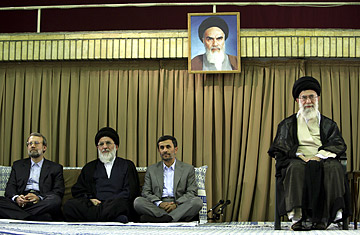
From left: Parliament speaker Ali Larijani, judiciary chief Ayatullah Mahmoud Hashemi Shahroudi, President Mahmoud Ahmadinejad and Supreme Leader Ayatullah Ali Khamenei sit under a portrait of Ayatullah Khomeini during a meeting in Tehran on July 20, 2009
Are the wheels coming off the Iranian regime bus? On July 26, President Mahmoud Ahmadinejad fired the country's Intelligence Minister, Gholam Hossein Mohseni Ejeie, a man who customarily reported directly to the Supreme Leader, Ayatullah Ali Khamenei, rather than to the President. The move came a day after Khamenei had forced Ahmadinejad to drop Esfandiar Rahim Mashaie as his candidate for Vice President. But in an act of flagrant defiance of Khamenei, Ahmadinejad appointed Mashaie as his chief of staff. All this suggests that a political brawl is raging within the corridors of power, the likes of which the world has not seen since Ayatullah Ruhollah Khomeini died in 1989.
It is bad enough that Khamenei is fighting with the man he backed for President, but what really keeps the Supreme Leader awake at night is Khomeini's ghost. In the West, many fall back on the easy assumption that the demonstrations protesting the June 12 election expressed a desire for liberal democratic reform. While there may be some truth to that, the opposition leaders — the candidates who lost the June 12 election — are fighting for something else: the mantle of the 1979 revolution. They believe they are the true inheritors of Khomeini's legacy. They call themselves the followers of Beit-i Khomeini, the House of Khomeini. They are the pure, untainted revolutionaries who view Khamenei as a usurper.
Former Prime Minister Mir-Hossein Mousavi is the public face of the opposition, but there are many others who are just as important, from former Presidents Mohammed Khatami and Ali Akbar Hashemi Rafsanjani to many grand ayatullahs in Qom, Iran's Vatican. Mousavi was chosen as spokesman for the opposition because of his impeccable revolutionary credentials. Even at the revolution's most militant violent and radical peak, Mousavi stood by Khomeini, never questioning his decisions. It was an office under Mousavi that coordinated a series of attacks against the U.S. in Lebanon, including an attack on the U.S. embassy. And when Khomeini died, Mousavi played an Iranian Cincinnatus, retreating from politics and living as a common man. When Khamenei tried to impugn Mousavi's revolutionary credentials after the demonstrations started, insinuating that he answers to foreign powers, Iranians put absolutely no credence in it.
Khamenei must be considering the risks of arresting Mousavi to put an end to protests. He certainly has the authority and power to do so. Since the election, the Revolutionary Guards, which report directly to Khamenei, have all but imposed a military dictatorship over the country. Its volunteer vigilantes, the Basij, along with the secret police, are the ones beating up and arresting demonstrators. But arresting Mousavi, Khomeini's political scion, would be akin to arresting Thomas Jefferson.
The fight between Khamenei and the opposition candidate is almost personal. Mousavi's retirement from government in 1989 coincided with Khamenei's appointment as Supreme Leader. Mousavi had reportedly detested Khamenei, considering him a usurper — Khamenei was not an ayatullah when he succeeded Khomeini. Even today his clerical credentials are suspect. He has absolutely no spiritual following among the world's Shi'ites.
In fact, few of the leaders of the 1979 revolution accepted Khamenei as their leader in spite of his selection by the Assembly of Experts. Khomeini was too ill at the time to understand the implications of making Khamenei Supreme Leader. Their mistrust, the opposition believes, was justified. Khamenei has failed to uphold Khomeini's legacy, turning the country into a military camp run by the Revolutionary Guards.
Download the new TIME BlackBerry App at app.time.com
